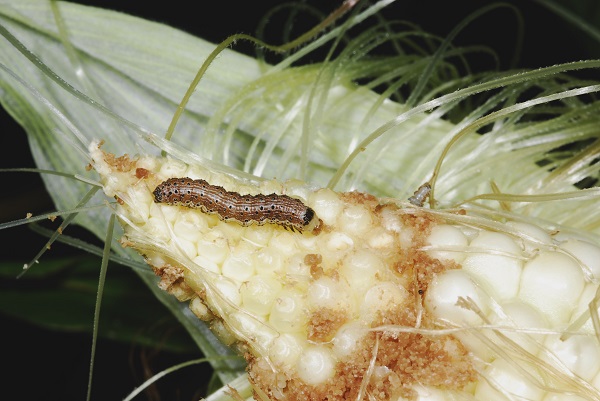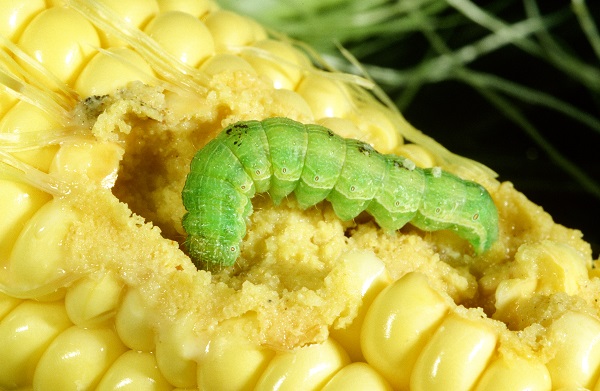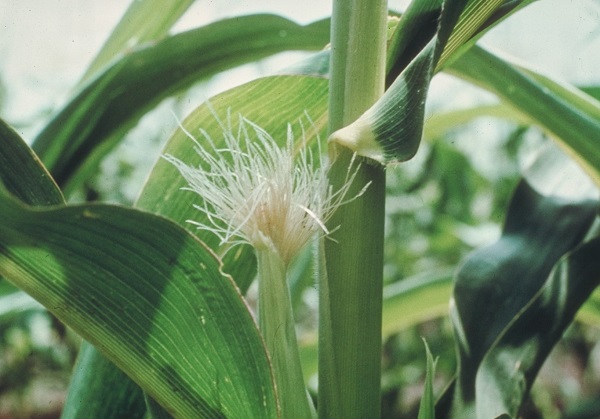Corn Earworm Management in Sweet Corn
ENTFACT-318: Corn Earworm Management in Sweet Corn | Download PDF
Ric Bessin, Extension Specialist
University of Kentucky College of Agriculture
Corn earworm is potentially the greatest threat to sweet corn production in Kentucky. Because it feeds directly on the market product, is difficult to control, and is common in high numbers at the end of the season, most insecticides used on sweet corn target this pest. Once earworm has become established within the ear, control is impossible. Earworms spend a relatively short period of their life feeding in a site that can receive an adequate insecticide application. A effective program, especially on late season corn, is necessary to ensure that damaged ears are kept to a minimum.
Currently, the primary insecticides used for corn earworm control in sweet corn belong to the pyrethroid class. There is growing concern that corn earworm in some regions of the Midwest has developed resistance to this class of insecticides. Some field failures have been reported.

Figure 1. A young corn earworm larva feeding on a tip of an ear.
Earworms are variable in color, but they have a brown head without markings and numerous microscopic spines covering their body. Corn earworms are moderately hairy larvae that vary from yellow, to green, to red to brownish black. They may be found feeding in the ear tips following silking. The larvae are cannibalistic, rarely is their more than one per ear or whorl.

Figure 2. Although variable in color, corn earworm larvae feel rough to the touch.
The moth has a wing span of 1 to 1-1/2 inches. The front wings of the male are usually a light yellowish olive; those of the female are yellowish brown to pinkish brown. Each forewing has a dark spot in the center. The dome-shaped-egg is usually white when first laid but develops a reddish-brown band before hatching.
Biology
Corn earworms overwinter as pupae in underground cells. Some adults from these pupae begin to emerge as early as late March, others may not appear until August. There are generally four generations each year, however, overlap is great and adult moths that can lay eggs may be present in significant numbers throughout most of the growing season.

Figure 3. Initial corn earworm sprays are applied when silks first emerge.
Female moths search out fresh silks on which to lay single eggs. Following hatch, the small larvae often eat the egg shell before beginning to feed on the silk. Within a day or so they move down the silks to the tip of the ear. Corn earworms generally complete their development in 14 to 16 days. Full-grown worms leave the ear and pupate in the soil. The new adult will be active in another 10 to 14 days. Damage to the kernels in the tip make the ear more attractive to sap beetles.
Cultural Controls
There are a number of approaches that growers can implement to control corn earworm besides just spraying insecticides. This includes selecting the best varieties and planting dates. Varietal selection is very important. Corn hybrids having a long, tight fitting shuck appear to suffer less damage than those with loose shucks. The key factor determining the relative risk of corn earworm attack is planting date. Early and midseason we typically have fewer corn earworm moths to lay eggs on the silks. But late-planted corn will be late-silking corn, and many more moths are searching for egg-laying sites at this time. In addition, late in the season, the field corn crop is producing high numbers of corn earworm moths and is not attractive to the moths for egg laying.
Spray Coverage
Spray solution should be driven deep into the silks to be of maximum benefit. The center third of the plant is the only zone that needs to be protected. Ground application has always been shown to be superior to aerial application, particularly when using drop nozzles on each side of the row directed towards the ears. A spray pressure of 30 psi or higher is recommended.
Preventive Management
A preventive program against corn earworms may begin when 10% of the ears are silked. Repeated sprays at three to five day intervals until 90% of the silks have wilted should give a high percentage of worm free ears during early and midseason. Control is more difficult late in the season. Even shortening spray intervals may produce only 90% clean ears.
An IPM Approach
Since moth intensity varies considerably during the season, it makes good sense to monitor adult activity and adjust the need for sprays accordingly. Pheromone traps need to be examined twice a week for corn earworms beginning in early June to determine moth activity and the need to spray. Special attention should be given to late planted fields and fields with green silks. Moths should be removed from traps, counted, destroyed, and removed from the field during each visit.
Economic Threshold: When tassels emerge and silks are still green, numbers of corn earworm moths captured in pheromone traps will determine the frequency of insecticide applications.

Bt Sweet Corn
Similar to Bt field corn, Bt sweet corn has been genetically engineered with a protein that kills certain caterpillars. It is very selective, safe to beneficial insects, and has been approved for commercial production. However, not all of the technologies are "bullet proof" when planted late there can be considerable earworm damage to Bt sweet corn. The highest level of protection is afforded with the Attribute II Bt sweet corn. Bt sweet corn still needs to be monitored and in some situations may need to be sprayed to prevent infestation with corn earworm.
Revised: 11/19
CAUTION! Pesticide recommendations in this publication are registered for use in Kentucky, USA ONLY! The use of some products may not be legal in your state or country. Please check with your local county agent or regulatory official before using any pesticide mentioned in this publication.
Of course, ALWAYS READ AND FOLLOW LABEL DIRECTIONS FOR SAFE USE OF ANY PESTICIDE!
Photos courtesy Ric Bessin, University of Kentucky Entomology
